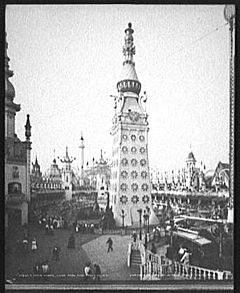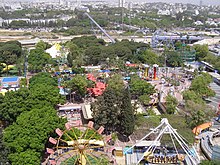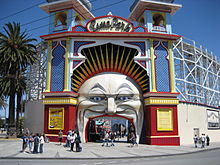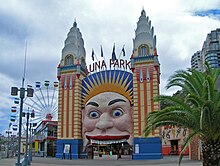Luna Park is a name shared by dozens of currently operating and defunct amusement parks. They are named after, and partly based on, the first Luna Park, which opened in 1903 during the heyday of large Coney Island parks. Luna parks are small-scale attraction parks, easily accessed, potentially addressed to the permanent or temporary residential market, and located in the suburbs or even near the town center. Luna parks mainly offer classic funfair attractions (great wheel), newer features (electronic displays) and catering services.[1]

History edit
The original Luna Park on Coney Island, a massive spectacle of rides, ornate towers and cupolas covered in 250,000 electric lights, was opened in 1903 by the showmen and entrepreneurs Frederic Thompson and Elmer "Skip" Dundy. The park was either named after the fanciful airship Luna, part of the new park's central attraction A Trip to the Moon, or after Dundy's sister.[2][3] Luna Park was a vastly expanded attraction built partly on the grounds of Sea Lion Park, the first enclosed amusement park on Coney Island which closed down due to competition from nearby Steeplechase Park.
In 1905, Frederick Ingersoll, who was already making a reputation for his pioneering work in roller coaster construction and design (he also designed scenic railroad rides) borrowed the name when he opened Luna Park in Pittsburgh and Luna Park in Cleveland. These first two amusement parks, like their namesake, were covered with electric lighting (the former was adorned with 67,000 light bulbs;[4] the latter, 50,000[5]). Later, in 1907, Charles Looff opened another Luna Park in Seattle, Washington. Ultimately, Ingersoll opened 44 Luna Parks around the world, the first chain of amusement parks. For a short time, Ingersoll renamed his parks Ingersoll's Luna Park to distinguish them from the Luna Parks to which he had no connection.[6] Ingersoll's death in 1927 and the closing of most of his Luna Parks did not stop new parks from taking the name.
Today, the term luna park or lunapark is a noun meaning "amusement park" in several languages, including Indo-European languages such asPolish, French, Italian, Russian, Croatian, Serbian, Bosnian, Slovenian, and Greek (λούνα παρκ, loúna park),[7] as well as Turkish,[8] Hungarian and Hebrew (לוּנָה פַּארְק, but the term גן שעשועים lit. 'park of amusements' is also widely used).[9]
List of Luna Parks edit
In Africa edit
| Name | Location | In operation | Notes |
|---|---|---|---|
| Luna Park, Cairo[10] | Heliopolis, Egypt | 1911 to 1915 | The first in Africa and the Middle East.[11] On January 19, 1915, the buildings and grounds were converted into Australian Auxiliary Hospital at Luna Park for World War I.[12] The hospital was closed on July 10, 1916.[13] |
| Luna Park, Obala[14] | Obala, Cameroon | 1970 to 2000 |
In Asia edit



| Name | Location | In operation | Notes |
|---|---|---|---|
| Luna Park, Abha | Saudi Arabia | ? to present | Part of the Abha Palace complex[15] |
| Alanya Lunapark[16] | Near Alanya, Turkey | ? to present | |
| Luna Park, Baku[17] | Baku, Azerbaijan | 2000 to 2005 | |
| Luna Park, Beirut | Beirut, Lebanon | 1966 to present | |
| Luna Park, Bombay[6] | Mumbai, India | Designed and built by Ingersoll | |
| Bostanci Lunapark | Bostancı, Turkey | 1983 to present | |
| Eski Lunapark | Near Balıkesir, Turkey | ? to present | |
| Kültürpark Lunapark | Konak, İzmir, Turkey | ? to present | |
| Girne Lunapark | Karşıyaka, İzmir, Turkey | ? to 2010 | |
| Mersin Lunapark | Mersin, Turkey | ? to present | |
| Lunapark, Nazilli | Nazilli, Turkey | ? to present | |
| Sincan Lunapark | Sincan, Turkey | ? to present | |
| Luna Park, Larnaca | Larnaca, Cyprus | ? to present | Now known as Lucky Star Park[18] |
| Luna Grand Park[19] | Haifa, Israel | 2001 to 2013 | Closed after five months due to poor attendance following a religious boycott[20] and reopened after negotiations with the local religious community.[21] Closed for good on October 31, 2013 to make room for a new cinema.[22] |
| Luna Park, Tel Aviv[23][24] | Tel Aviv, Israel | 1970 to present | The Luna Park was located in Jaffa from 1953 to 1970, when it was relocated.[25] |
| Luna Park, Hong Kong[26] | North Point, Hong Kong Island, Hong Kong | 1949 to 1954 | Amusement park, cinema and nightclub complex |
| Luna Park, Osaka[27] | Osaka, Japan | 1919 to 1923 | Also known as Shinsekai Luna Park[28] |
| Luna Park, Tokyo | Tokyo, Japan | 1910 to 1911 | Burned down in 1911[29][30] |
| Luna Park, Tehran | Tehran, Iran | 1970s to 1980 | Reopened in 1988 as Shahr-e Bazi; closed 2007 to make room for new highway[31] |
| Luna Park, Yerevan | Yerevan, Armenia | 2000 to present |
In Europe edit



| Name | Location | In operation | Notes |
|---|---|---|---|
| Luna Park, Aidonakia | Athens, Greece | 2001 to present | Constructed by Ingersoll. Also known as Ta Aidonakia, 'the little nightingales'.[5] |
| Fantasia Luna Park | Near Faliraki, Greece | 2003 to present | |
| International Luna Park | Near Athens, Greece | ? to present | |
| Luna Park, Brent Cross | London, UK | 2020 to Present | |
| Luna Park, Berlin | Berlin, Germany | 1909 to 1933 | In its time, it was the largest amusement park in Europe[32] |
| Luna Park, Cologne[33] | Cologne, Germany | 1909 to 1927 | |
| Luna Park Hamburg-Altona | Hamburg, Germany | 1913, and again 1917 to 1923 | |
| Luna Park, Leipzig | Leipzig, Germany | 1911 to 1932 | |
| Luna Park, Saint-Brieuc, France | Saint-Brieuc, France | 1982 to present | Located in the Brézillet area of Saint-Brieuc, Côtes-d'Armor, France[34] |
| Luna Park, Cap d'Agde[35] | Cap d'Agde, France | ? to present | |
| Luna Park, Fréjus[36] | Fréjus, France | ? to present | |
| Luna Park, La Palmyre | La Palmyre, France | ? to present | |
| Luna Park, Paris[37] | Paris, France | 1909 to 1931 | |
| Luna Park, Argelès-sur-Mer | Argelès-sur-Mer, France | ? to present | |
| Luna Park, Nice | Nice, France | ? to present | |
| Luna Park Funfair | Scarborough, North Yorkshire, England, United Kingdom | ? to present | |
| Luna Park, Geneva[38][39] | Le Parc des Eaux Vives alongside Lake Geneva, Switzerland | 1912 to 1918 | |
| Luna Park, L'Escala | L'Escala, Spain | ? to present | |
| Lunapark, Łódź[40] | Łódź, Poland | Closed January 2016 | |
| Lunapark Sowinski | Near Władysławowo, Poland | 2006 to present | |
| Luna Park, Odesa[41] | Odesa, Ukraine | ? to present | |
| Luna Park, Rome[6] | Rome, Italy | ? to 1930s | Designed and built by Ingersoll |
| LunEur[42][43] | Rome, Italy | 1953 to 2008 2016 to present | |
| Luna Park, Milan | Near Milan, Italy | 1965 to present | Name was changed April 11, 2004 to Luna Europark Idroscalo Milano[44] |
| Luna Park, Moscow[45] | Moscow, Russia | 1993 to present | Officially called "Luna Park Carousel". |
| Luna Park, St. Petersburg | Saint Petersburg, Russia | May 1912 to 1924 | |
| Luna Park, Skopje | Skopje, North Macedonia | ? to 2022 | |
| Luna Park, București | București, Romania | 1920s-1936 | First amusement park in Romania, it also had the 1st and only true roller coaster in the country. Demolished in 1936 to make space for a department store. |
In North America edit


| Name | Location | In operation | Notes |
|---|---|---|---|
| Luna Park, Alexandria County | Alexandria County (now Arlington County), Virginia, U.S. | 1906 to 1915 | Designed and built by Ingersoll. Some sources refer to it as Washington Luna Park or Luna Park, Washington, D.C.[46] |
| Luna Park, Buffalo | Buffalo, New York, U.S. | 1904 to 1920 | Designed and built by Ingersoll. Damaged by fire July 14, 1909[47] Originally Carnival Court, became Athletic Park before closing[48] |
| Luna Park, Charleston[49][50][51] | Charleston, West Virginia, U.S. | 1912 to 1923 | Most of the park burned down in 1923 after its roller coaster caught fire; now single-family housing. |
| Luna Park, Chicago | Chicago, Illinois, U.S. | 1907 to 1911 | Owned by James "Big Jim" O'Leary, boxing promoter who was son of Mrs. O'Leary of Great Chicago Fire fame[52][53][54][55] |
| Luna Park, Cleveland | Cleveland, Ohio, U.S. | 1905 to 1929 | Designed by Ingersoll. Former site of Luna Bowl stadium for American football and Negro league baseball games[6] |
| Luna Park, Coney Island | New York City, New York, U.S. | 1903 to 1944 | First Luna Park and forerunner of amusement park chain.[6] Now a housing development. |
| Luna Park, Coney Island (opened 2010) | New York City, New York, U.S. | 2010 to present | Constructed on the site of the former Astroland (across the street from the original Luna Park). |
| Luna Park, Denver | Denver, Colorado, U.S. | 1908 to 1914 | Constructed on the site of the first US amusement park west of the Mississippi River, known as Manhattan Beach (1881–1908)[56] |
| Luna Park, Detroit | Detroit, Michigan, U.S. | 1906 to 1927 | Was actually named Electric Park but also called Luna Park, Riverview Park, and Granada Park (Ingersoll Amusement Center was a separate park[6]) |
| Luna Park, Honolulu[6] | Honolulu, Hawaii, U.S. | Closed down unknown time. | Designed and built by Ingersoll. |
| Luna Park, Houston[57] | Houston, Texas, U.S. | 1924 to c. 1934 | Much of the site now businesses near a residential development; the northern and eastern edges now covered by Interstate 10 and Interstate 45. |
| Luna Park, Hull[58] | Gatineau, Quebec, Canada | 1925 to 1928 | |
| Luna Park, Johnstown | Johnstown, Pennsylvania, U.S. | Originally Roxbury Park; renamed Luna Park in 1905; sold to Johnstown in 1922; renamed Roxbury Park[59] | |
| Luna Park, Los Angeles | Los Angeles, California, U.S. | 1911 to 1914 | Was Chutes Park 1900–1910[60][61] |
| Luna Park, Mansfield[62][63][64] | Mansfield, Ohio, U.S. | 1905 to ? | Also known as Casino Park |
| Luna Park, Mexico City[4] | Mexico City, Mexico | 1906 to ? | Designed by Ingersoll. On the same site as Luna Loca.[5] |
| Luna Park, Olcott Beach[48][65] | Newfane, New York, U.S. | 1898 to 1926 | Destroyed by fire in 1927[66] |
| Luna Park, Pittsburgh | Pittsburgh, Pennsylvania, U.S. | 1905 to 1909 | Was first of the Ingersoll Luna Parks and first amusement park to be covered with electric lighting[5] |
| Luna Park, Portland | Portland, Oregon, U.S. | 1903 to 1944 | |
| Luna Park, San Jose[61] | San Jose, California, U.S. | 1910 to 1916 | Included a baseball stadium that served as home for the San Jose Prune Pickers and San Jose Bears of the California State League.[67] |
| Luna Park, Schenectady[68] | Rexford, New York, U.S. | 1901 to 1933 | Designed and built by Ingersoll. Was also known as Dolle's Park, Colonnade Park, Palisades Park, and Rexford Park[69][70][71][72][73] |
| Luna Park, Scranton | Scranton, Pennsylvania, U.S. | 1906 to 1916 | Constructed by Ingersoll.[74][75] Most of grounds now covered by Interstate 81. |
| Luna Park, Seattle | Seattle, Washington, U.S. | 1907 to 1913 | Designed by Looff.[76] |
| Luna Park, Sylvan Beach | New York City, New York U.S. | ? | Absorbed by nearby Carnival Park[48][77] |
| Luna Park, West Hartford[78][79][80] | West Hartford, Connecticut, U.S. | 1906 to 1930 | Name changed from White City just before the park's grand opening. |
| Luna Park, Wheeling | Wheeling, West Virginia, U.S. | 1905 to 1907 |
In Oceania edit


| Name | Location | In operation | Notes |
|---|---|---|---|
| Luna Park Glenelg | Glenelg, South Australia, Australia | 1930 to 1934 | Closed due to objections of local populace to Sunday operations and expansion plans;[81] moved to Milsons Point (1935) and became Luna Park Sydney. |
| Luna Park Melbourne[5] | Melbourne, Victoria. Australia | 1912 to present | Designed and built by Ingersoll. Oldest operational Luna Park and famous for having the oldest continually operating roller coaster in the world. |
| Luna Park Redcliffe[82][83][84] | Redcliffe, Queensland,Australia | 1944 to 1966 | Erected on an unused section of the foreshore just north of Sutton's Beach at Redcliffe Point in late 1944. Owners, Redcliffe Town Council appointed Messrs W. Scott and Philip Wirth as amusement managers. Later the enterprise was sold by the Redcliffe Town Council to local businessman Hal Buchanan who sold it on to the Roman Catholic Archdiocese of Brisbane, which sold it again in 1952. Amusements included a steam train, ferris wheel, sideshows and car-rides as well as a salt-water swimming pool.[83][85][86][87][88][89][90] |
| Luna Park Sydney | Sydney, New South Wales, Australia | 1935 to 1979, 1982 to 1988, 1995 to 1996, 2000 to 2001, 2004 to present | Originally known as Luna Park Milsons Point[91] |
| Luna Park Scarborough[81][92] | Scarborough, Western Australia, Australia | November 25, 1939[93][94][95] to 1972 | |
| Luna Park Auckland | Auckland, North Island, New Zealand | 1926 to 1931 | Established on Auckland's Waitemata Harbour, using rides and equipment from the New Zealand and South Seas Exhibition, a world fair that ran in Dunedin, New Zealand, from 1925–1926. Due to the depression, Luna Park began to run at a loss and was shut down in 1931.[96] |
In South America edit

| Name | Location | In operation | Notes |
|---|---|---|---|
| Luna Park, Buenos Aires | Buenos Aires, Argentina | 1934 to present | Designed and built by Ingersoll. Became site of a sports arena built 1931–1934.[6] As of 2013, it still runs, serving as a venue for stage concerts & presentations, both national and international, and as a sports arena. Acclaimed international shows such as Disney on Ice and the Harlem Globetrotters have performed in Argentine Luna Park. It is known for its adaptability to host ice-skating rinks, multiple stages, sports courts, and others. |
| Luna Park, Rio de Janeiro | Rio de Janeiro, Brazil | ? to 2006 | Now used to store portable amusement rides by owner Orlando Orfei; often called Luna Park, Nova Iguaçu |
| Lunapark, Lima | Lima, Peru | ? to 2007 | |
| Lunapark, Lecherias | Anzoátegui, Venezuela | 2003 to present | Also known as Parque de Atracciones Plaza Mayor |
| Luna Park, Santa Fé | Bogotá, Colombia | 1921 to 1948 | Designed and built by Don Nicolás Liévano where today sits the neighborhood of Barrio Restrepo. The park was built around a lake fed by the Fucha River. It counted with several attractions including the Chicago Ferris wheel, a carrousel, a building for events, and more. Designed to entertain families and children of the south of Bogotá it was also used for parades and events during special occasions. By 1948 the luna park construction company decided to fill the lake and build residential areas on top which was supported by the secretary of public works of Bogotá disregarding the protests by the locals against the project. |
See also edit
